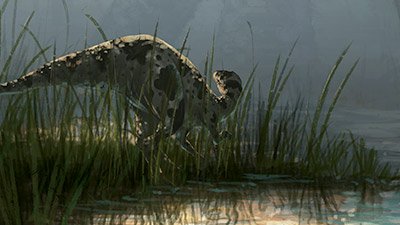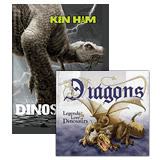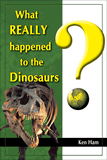
Tree-Climbing Velociraptors
Velociraptor: the fearsome carnivore and . . . tree climber?
News Source
- New Scientist: “Velociraptor’s ‘Killing’ Claws Were for Climbing ”
According to a group of researchers led by Phil Manning of the University of Manchester, popular images of Velociraptor using its menacing claws to disembowel its prey may be off the mark. In fact, the group revealed in 2005 that the dinosaur’s claws were not sharp enough for such a feat.1 Instead, Velociraptor likely used the claws to cling to prey while attacking with its teeth.
However, the new wrinkle to this story is that
an analysis of the biomechanics of the hand claw suggests it could have supported the dinosaur’s weight when it was climbing . . . . [It] used its climbing ability to perch in trees and pounce on prey from above, with its claws puncturing the skin so it could cling to its victim’s body while biting and subduing it.
To the researchers, this is further buttressed by the assumption that Microraptor, a supposed ancestor of Velociraptor, had feathered limbs that allowed it to glide down from the trees to attack prey.
There are several points creationists should consider concerning this find:
- Once again, we see that assumptions and expectations lead to misperceptions about extinct species, especially in light of the false impression of Velociraptor given by the popular Jurassic Park books and movies. Even in this news release, the fact that the dinosaur’s claws can support its weight does not reveal how this feature was used. The researchers simply assume the dinosaurs could climb trees. They may have shimmied out onto limbs; they may have only used the claws to cling to prey; and they may not have used them at all. Fossils don’t reveal the whole picture; scientists fill in a number of details based on beliefs and assumptions.
- We should always be cautious in assuming that menacing teeth or claws necessarily mean that those features were solely used for killing. Creatures before the Fall did not use them that way, and some creatures today don’t. For example, pandas have sharp teeth for eating bamboo, and sloths have dangerous looking claws for defense, climbing, and swimming. Without the living animals around, one might very well think from fossils that those features were attack structures.
- Finally, the scientists’ bias comes through in their reasoning as to why Velociraptor could have been a climber: because birds descended from dinosaurs. Putting dinosaurs in trees makes this seem more plausible to the imagination—even if there is no concrete evidence they ever perched on branches and waited to pounce on prey. The tenuous proof is the assumption that Microraptor was an ancestor to the dromeosaur family, coming “50 million years” earlier. The main flaw with this thinking, however, is that Microraptor shows strong evidence of being fully a bird, similar in some ways to Archaeopteryx (another bird). Thus, according to this supposition, not only did dinosaurs evolve into birds, they also devolved back into larger, tree-climbing dinosaur descendants. The less convoluted, more logical explanation is that birds and dinosaurs are separate created kinds with amazing diversity.
Dinosaur-to-bird evolution has become so unquestioned that most dinosaur discoveries include some link to bird behavior or characteristics. If it’s not feathers, it’s jumping out of trees. Dinosaurs such as Velociraptor get grafted into the family line of Microraptor simply because the scientists presuppose that birds descended from dinosaurs before they even look at the evidence. Too bad that real science continues to be ambushed by the hype.
Further Reading
- Did Microraptor gui Invent the Biplane Before the Wright Brothers?
- Two Fighting Dinosaurs?
- Did Dinosaurs Turn into Birds?
- Get Answers: Dinosaurs, Fossils, Created Kinds (Baraminology)
For More Information: Get Answers
Remember, if you see a news story that might merit some attention, let us know about it! (Note: if the story originates from the Associated Press, FOX News, MSNBC, the New York Times, or another major national media outlet, we will most likely have already heard about it.) And thanks to all of our readers who have submitted great news tips to us. If you didn’t catch all the latest News to Know, why not take a look to see what you’ve missed?
(Please note that links will take you directly to the source. Answers in Genesis is not responsible for content on the websites to which we refer. For more information, please see our Privacy Policy.)
Footnotes
- “Raptor Inflicted Death by a Thousand Bites,” New Scientist, October 19, 2005, https://www.newscientist.com/article/mg18825224.600-raptor-inflicted-death-by-a-thousand-bites/.
Recommended Resources

Answers in Genesis is an apologetics ministry, dedicated to helping Christians defend their faith and proclaim the good news of Jesus Christ.
- Customer Service 800.778.3390
- © 2024 Answers in Genesis






